
Introduction
In the previous chapter, we discussed various types of Japanese candlesticks patterns. In this chapter, we will turn our focus to bar patterns. Bar patterns are similar to candlestick patterns. However, they are not as visually appealing as are candlestick patterns. Because of their less appealing nature, there are not as many bar patterns as there are candlestick patterns. In this chapter, we will be discussing about the most common types of bar patterns. Keep in mind that bar patterns can play an important role when they appear after an extended up move or down move i.e. near the termination point of a trend. Also keep in mind that just like candle patterns, bar patterns are very short-term patterns, and as such do not expect a major reversal in trend when you spot them. Having said that, on some occasions, these patterns can indeed appear as an important reversal patterns. Bar patterns will appear across all the time frames – minute, hours, days, weeks, months etc. The larger the time frame, the greater is the significance of a bar pattern in terms of the magnitude of the forthcoming move.
Bar patterns
These are the bar patterns that we will be discussing in this chapter:
-
Inside bar
-
Outside bar
-
Two-bar reversal
Inside bar
An inside bar is a two-bar reversal pattern that appears after a rally in price or after a decline in price. This pattern is the same as the harami pattern that we discussed in the previous chapter. An important thing to keep in mind is that this pattern is more reliable when it forms after a period of sustained up move or down move. Another important thing to keep in mind is that the taller the first bar relative to the preceding bars and the shorter the second bar relative to the first bar, the stronger is the pattern. Also keep an eye on the volume characteristics during and after the completion of the inside bar pattern. Preferably, the second bar should have significantly less volume than the first bar, while there should be a pickup in volume during the subsequent bars after the second bar to signal that a short-term reversal has taken place.
Bullish inside bar
A bullish inside bar appears after a sustained decline in price. In case of a bullish inside bar, the first bar is a tall bar that usually has a close below the open, suggesting that sellers are still the dominant force. Meanwhile, the second bar is contained within the range of the first bar, suggesting at an equilibrium between buyers and sellers. Because we are looking at a bullish reversal, it is preferable that the second bar has a close above the open. A short-term reversal in trend is signalled when, in the following bars, price breaks above the high of the second bar and buying continues.
Bearish inside bar
A bearish inside bar appears after a sustained rally in price. In case of a bearish inside bar, the first bar is a tall bar that usually has a close above the open, suggesting that buyers are still the dominant force. Meanwhile, the second bar is contained within the range of the first bar, suggesting at an equilibrium between buyers and sellers. Because we are looking at a bearish reversal, it is preferable that the second bar has a close below the open. A short-term reversal in trend is signalled when, in the following bars, price breaks below the low of the second bar and selling continues.
In chart 9.2.1.a, notice the appearance of a bullish inside bar pattern following a decline in price. The first bar is a long bearish bar that opened near the highs and closed near the lows. The second bar is a very short bar that is contained well within the first bar. Also, the second bar has a close above the open. These in turn suggest at equilibrium between buyers and sellers. Post the completion of the second bar, the security traded sideways for the next four sessions, and then started to rally sharply over the next several sessions.
In chart 9.2.1.b, notice the appearance of a bearish inside bar pattern following a strong rally in price. The first bar is a long bullish bar that has an opening in the lower half of the range and a closing near the high. The second bar opened right at the high and then fell steadily during the day to close near its low. Also, the second bar is contained inside the range of the first bar. Post the completion of the second bar, the security inched lower over the next few sessions before again testing the highs of the inside bar. This again brings us to an important point that bar patterns do not always lead to a major reversal in trend.
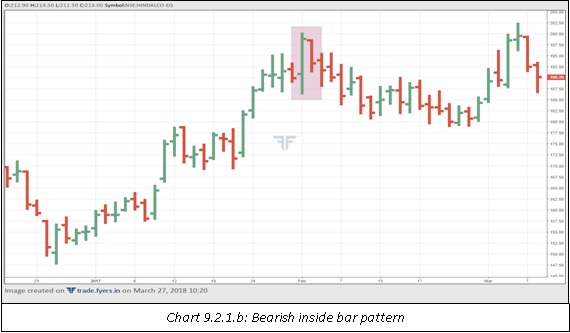
Outside bar
An outside bar is a two-bar reversal pattern that appears after a rally or a decline in price. This pattern is similar to the engulfing pattern that we discussed in the previous chapter but with one difference: in an engulfing pattern, the body of the second candle must engulf the body of the first candle; while in an outside bar, the entire second bar must engulf the entire first bar. Keep in mind that this pattern is more reliable when it forms after a period of sustained up move or down move. Furthermore, the taller the second bar relative to the first and the preceding bars, the stronger is the pattern. Also, keep an eye on volume characteristics during and after the completion of the outside bar pattern. Preferably, the second bar should have significantly more volume than the first and the preceding bars, as such a development increases the odds of a short-term reversal in trend.
Bullish outside bar
A bullish outside bar appears after a sustained decline in price. In case of a bullish outside bar, the first bar is a short bar that usually has a close below the open, suggesting that sellers are still the dominant force. However, the small range of the first bar as compared to that of the preceding bars suggests that the selling pressure might be slowing down. Meanwhile, the second bar is a long bullish bar that completely engulfs the range of the first bar and closes near the high of the bar, suggesting at exhaustion in selling pressure and an increase in buying pressure. A short-term reversal in trend is signalled post the completion of the second bar.
Bearish outside bar
A bearish outside bar appears after a sustained rally in price. In case of a bearish outside bar, the first bar is a short bar that usually has a close above the open, suggesting that buyers are still the dominant force. However, the small range of the first bar as compared to that of the preceding bars suggests that the buying pressure might be slowing down. Meanwhile, the second bar is a long bearish bar that completely engulfs the range of the first bar and closes near the low of the bar, suggesting at exhaustion in buying interest and an increase in selling pressure. A short-term reversal in trend is signalled post the completion of the second bar.
In the chart 9.2.2.a, notice that the price was in a sharp downtrend until the emergence of the bullish outside bar pattern. The first bar is a relatively small bar compared to its predecessors and the second bar, which kind of suggests that the selling pressure is slowing down. The second bar opens near the close of the previous bar, but then rallies sharply to close near the high. It also completely engulfs the range of the first bar, suggesting that selling interest has probably ended and that a short-term reversal could be on the cards.
In the chart 9.2.2.b, notice the emergence of the bearish outside bar pattern after an up move in price. The first bar is a small bar that indicates uncertainty over the continuation of the uptrend. The second bar, meanwhile, opens right at the preceding bar’s high and then falls sharply to close near the low of the day. In doing so, the second bar completely engulfs the range of the first bar. Notice how the bearish outside bar pattern marked an end to the upside that was initiated by the appearance of the bullish outside bar pattern.
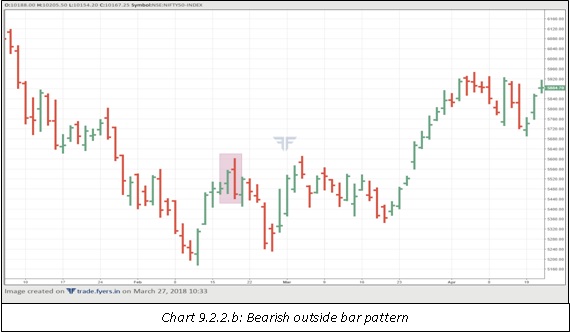
Two-bar reversal
A two-bar reversal, as the name suggests, is a reversal pattern that appears near the end of an uptrend or a downtrend. It sort of signals an exhaustion to the prevailing trend. A two-bar reversal is characterized by the appearance of two bars that are similar in size but opposite in direction – the first bar is in the direction of the prevailing trend while the second bar is against the direction of the prevailing trend. Both the bars should be long compared to the preceding bars and must preferably be accompanied by higher-than-usual volume.
Bullish two-bar reversal
A bullish two-bar reversal is a reversal pattern that appears near the end of a downtrend. The first bar opens near the high and then falls sharply to close near the low. This bar should be larger than its predecessors and should suggest that the downtrend remains very well intact. The second bar opens near the low, fails to sustain below the prior bar bottom, and then rallies sharply to close near the high of the current bar as well as that of the first bar. Strong bearish candle that is immediately accompanied by an equally strong bullish candle comes as a surprise to the bears and signals at a reversal in near-term trend.
Bearish two-bar reversal
A bearish two-bar reversal is a reversal pattern that appears near the end of an uptrend. The first bar opens near the low and then rallies sharply to close near the high. This bar should be larger than its predecessors and should suggest that the uptrend remains very much intact. The second bar opens near the high, fails to sustain beyond the prior bar peak, and then falls sharply to close near the low of the current bar as well as that of the first bar. Strong bullish candle that is immediately accompanied by an equally strong bearish candle comes as a surprise to the bulls and signals at a reversal in near-term trend.
In chart 9.2.3.a, notice the appearance of the bullish two-bar reversal pattern. Both the bars are long and similar in size, but in the opposite direction to each other. The first bar is a long bearish bar that opens near the high and closes near the low, thereby suggesting that the current downtrend remains intact. The second bar, however, opens near the prior bar close, fails to sustain below the prior bar low, and then rallies sharply to close near the prior bar open. The second bar leads to a complete change in perception and increases the likelihood of a short-term trend change.
In chart 9.2.3.b, notice the emergence of the bearish two-bar reversal pattern after a sustained rally in price. The first bar opens around the midpoint of the bar range but then closes above the opening level, suggesting that the uptrend remains intact. The second bar, however, opens near the high of the previous bar and then falls sharply as the day progresses, before closing near the low of the prior bar. After the completion of the pattern, price trade sideways for the next three sessions, before falling sharply thereafter.
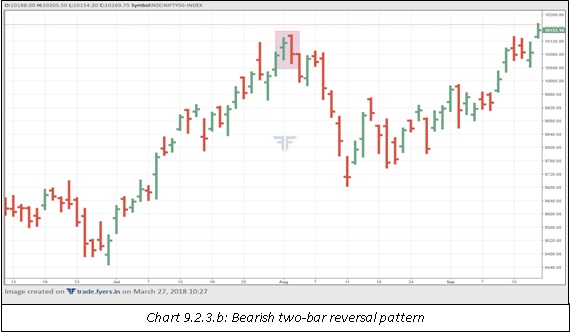
Summary
-
A bullish inside bar appears after a sustained decline in price. The first bar is a tall bar that usually has a close below the open. The second bar is contained within the range of the first bar, suggesting at an equilibrium between buyers and sellers.
-
A bearish inside bar appears after a sustained rally in price. The first bar is a tall bar that usually has a close above the open. Meanwhile, the second bar is contained within the range of the first bar, suggesting at an equilibrium between buyers and sellers.
-
A bullish outside bar appears after a sustained decline in price. The first bar is a short bar that usually has a close below the open. The second bar is a long bullish bar that completely engulfs the range of the first bar and closes near the high of the bar, suggesting at exhaustion in selling pressure and an increase in buying pressure.
-
A bearish outside bar appears after a sustained rally in price. The first bar is a short bar that usually has a close above the open. The second bar is a long bearish bar that completely engulfs the range of the first bar and closes near the low of the bar, suggesting at exhaustion in buying interest and an increase in selling pressure.
-
A bullish two-bar reversal is a reversal pattern that appears near the end of a downtrend. The first bar is a long bar that opens near the high and then falls sharply to close near the low. The second bar is an equally long bar that opens near the low and then rallies sharply to close near the high of the current bar as well as that of the first bar.
-
A bearish two-bar reversal is a reversal pattern that appears near the end of an uptrend. The first bar is a long bar that opens near the low and then rallies sharply to close near the high. The second bar opens near the high and then falls sharply to close near the low of the current bar as well as that of the first bar.
Next Chapter
Comments & Discussions in
FYERS Community

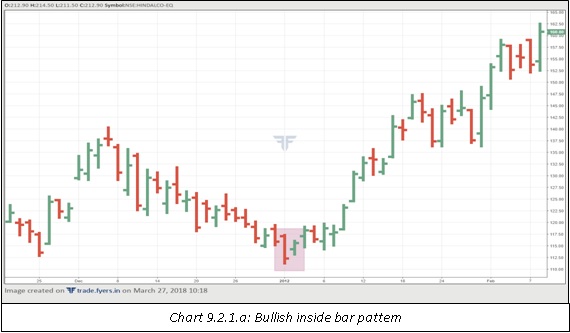
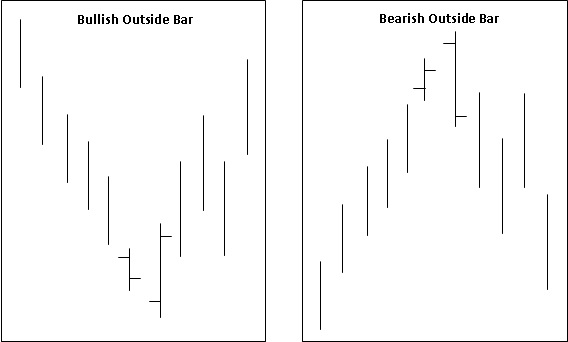
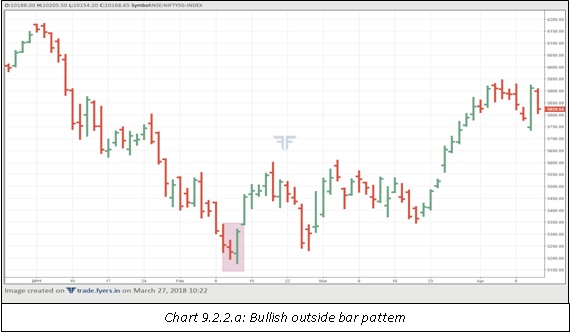

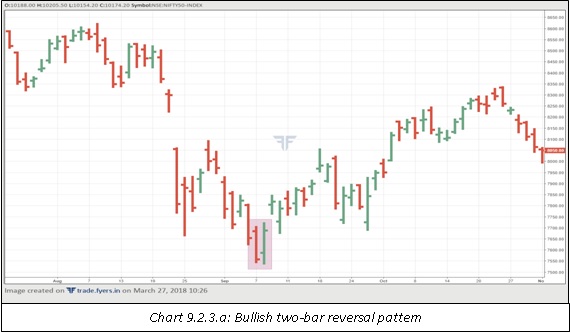
Vijay commented on April 24th, 2019 at 11:04 PM
It is very useful for beginners like us, and also please explain about Heiken ashi chart patterns.
Shriram commented on January 26th, 2020 at 5:35 PM
Hi Vijay, thank your for the feedback. We have explained Heikin Ashi in detail in a later chapter.
Sathya Ramesh commented on May 1st, 2019 at 10:02 PM
Really a good initiative by fyers team, Keep it up.
tejas commented on May 2nd, 2019 at 2:44 PM
Thx Satha!